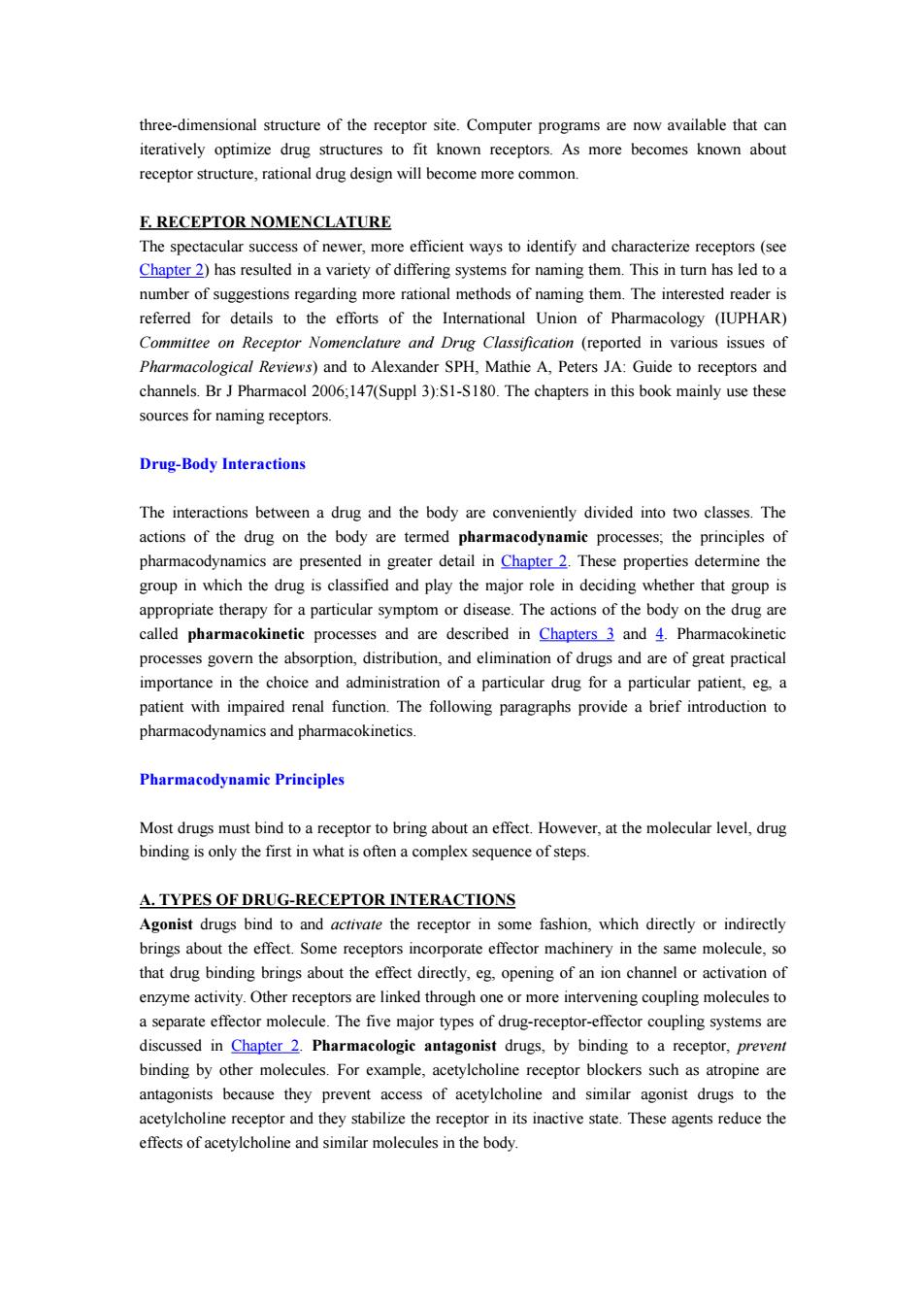正在加载图片...

three-dimensional structure of the receptor site.Computer programs are now available that can iteratively optimize drug structures to fit known receptors.As more becomes known about receptor structure,rational drug design will become more common. F.RECEPTOR NOMENCLATURE The spectacular success of newer,more efficient ways to identify and characterize receptors(see Chapter 2)has resulted in a variety of differing systems for naming them.This in turn has led to a number of suggestions regarding more rational methods of naming them.The interested reader is referred for details to the efforts of the International Union of Pharmacology (IUPHAR) Committee on Receptor Nomenclature and Drug Classification (reported in various issues of Pharmacological Reviews)and to Alexander SPH,Mathie A,Peters JA:Guide to receptors and channels.Br J Pharmacol 2006;147(Suppl 3):S1-S180.The chapters in this book mainly use these sources for naming receptors. Drug-Body Interactions The interactions between a drug and the body are conveniently divided into two classes.The actions of the drug on the body are termed pharmacodynamic processes;the principles of pharmacodynamics are presented in greater detail in Chapter 2.These properties determine the group in which the drug is classified and play the major role in deciding whether that group is appropriate therapy for a particular symptom or disease.The actions of the body on the drug are called pharmacokinetic processes and are described in Chapters 3 and 4.Pharmacokinetic processes govern the absorption,distribution,and elimination of drugs and are of great practical importance in the choice and administration of a particular drug for a particular patient,eg,a patient with impaired renal function.The following paragraphs provide a brief introduction to pharmacodynamics and pharmacokinetics. Pharmacodynamic Principles Most drugs must bind to a receptor to bring about an effect.However,at the molecular level,drug binding is only the first in what is often a complex sequence of steps. A.TYPES OF DRUG-RECEPTOR INTERACTIONS Agonist drugs bind to and activate the receptor in some fashion,which directly or indirectly brings about the effect.Some receptors incorporate effector machinery in the same molecule,so that drug binding brings about the effect directly,eg,opening of an ion channel or activation of enzyme activity.Other receptors are linked through one or more intervening coupling molecules to a separate effector molecule.The five major types of drug-receptor-effector coupling systems are discussed in Chapter 2.Pharmacologic antagonist drugs,by binding to a receptor,prevent binding by other molecules.For example,acetylcholine receptor blockers such as atropine are antagonists because they prevent access of acetylcholine and similar agonist drugs to the acetylcholine receptor and they stabilize the receptor in its inactive state.These agents reduce the effects of acetylcholine and similar molecules in the body.three-dimensional structure of the receptor site. Computer programs are now available that can iteratively optimize drug structures to fit known receptors. As more becomes known about receptor structure, rational drug design will become more common. F. RECEPTOR NOMENCLATURE The spectacular success of newer, more efficient ways to identify and characterize receptors (see Chapter 2) has resulted in a variety of differing systems for naming them. This in turn has led to a number of suggestions regarding more rational methods of naming them. The interested reader is referred for details to the efforts of the International Union of Pharmacology (IUPHAR) Committee on Receptor Nomenclature and Drug Classification (reported in various issues of Pharmacological Reviews) and to Alexander SPH, Mathie A, Peters JA: Guide to receptors and channels. Br J Pharmacol 2006;147(Suppl 3):S1-S180. The chapters in this book mainly use these sources for naming receptors. Drug-Body Interactions The interactions between a drug and the body are conveniently divided into two classes. The actions of the drug on the body are termed pharmacodynamic processes; the principles of pharmacodynamics are presented in greater detail in Chapter 2. These properties determine the group in which the drug is classified and play the major role in deciding whether that group is appropriate therapy for a particular symptom or disease. The actions of the body on the drug are called pharmacokinetic processes and are described in Chapters 3 and 4. Pharmacokinetic processes govern the absorption, distribution, and elimination of drugs and are of great practical importance in the choice and administration of a particular drug for a particular patient, eg, a patient with impaired renal function. The following paragraphs provide a brief introduction to pharmacodynamics and pharmacokinetics. Pharmacodynamic Principles Most drugs must bind to a receptor to bring about an effect. However, at the molecular level, drug binding is only the first in what is often a complex sequence of steps. A. TYPES OF DRUG-RECEPTOR INTERACTIONS Agonist drugs bind to and activate the receptor in some fashion, which directly or indirectly brings about the effect. Some receptors incorporate effector machinery in the same molecule, so that drug binding brings about the effect directly, eg, opening of an ion channel or activation of enzyme activity. Other receptors are linked through one or more intervening coupling molecules to a separate effector molecule. The five major types of drug-receptor-effector coupling systems are discussed in Chapter 2. Pharmacologic antagonist drugs, by binding to a receptor, prevent binding by other molecules. For example, acetylcholine receptor blockers such as atropine are antagonists because they prevent access of acetylcholine and similar agonist drugs to the acetylcholine receptor and they stabilize the receptor in its inactive state. These agents reduce the effects of acetylcholine and similar molecules in the body